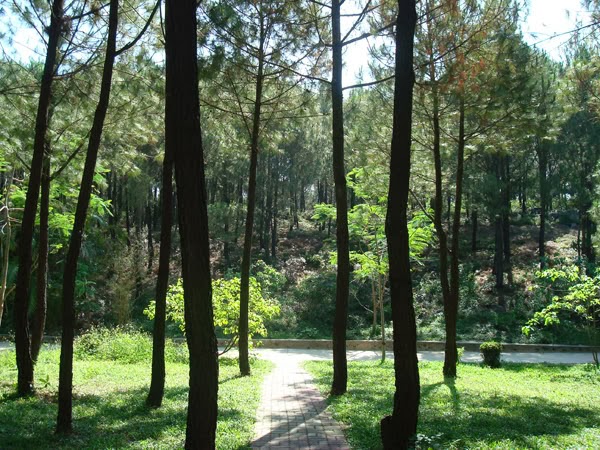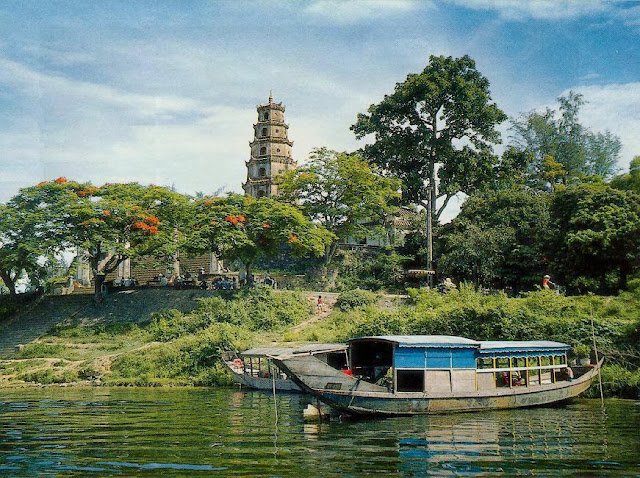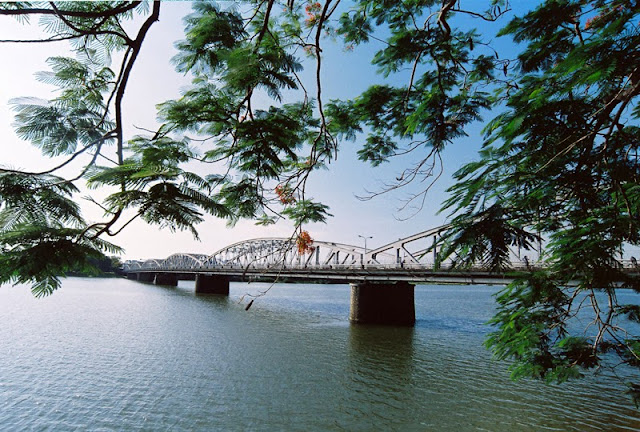The Huong River starts at Bang Lang junction, three
kilometers north of the mausoleum of Minh Mang, the second king of the Nguyen
Dynasty (1802-1945).
The junction is where the Ta Trach and Huu Trach, two rivers originating
in the Truong Son Range, meet to become the 30-kilometer-long river that is
often described as “beautiful” and “poetic” by Vietnamese writers.
 |
| The Ta Trach and Huu Trach River |
But for tourists the river is more than just a beautiful site: It is a
route connecting historical, religious, and cultural sites including the most
famous of all, the complex of Nguyen monuments that was named a UNESCO world
heritage site in 1993.
So I recommend you hire a boat and start downstream.
The first destination should be Thien Mu, a 400-year-old pagoda situated
on Ha Khe Hill on the left bank.
 |
| Thien Mu Pagoda and Phuoc Duyen Tower |
For Vietnamese, especially those who live in Hue, the complex is more
about the Phuoc Duyen Tower that was built in front of the pagoda in 1844. It
is 21 meters high and has seven floors, each with Buddha idols.
Both the pagoda and the tower are good places to observe the Huong River.
From the pagoda entrance, you can see how the river’s color changes through the
day, while the top of the tower gives you a clear view of how smoothly and
gently it flows.
After Thien Mu, the river passes Nguyet Bieu Village, which is believed
to date back to 1559, before the houses along its banks give way to trees and
hills.
The next destination is the wharf at the tomb of Tu Duc, the fourth
Nguyen king, but I advise you to skip the place. Instead, you should head to
Bau Ho Hill, which is a half hour walk from the wharf.
 |
| Tomb of Tu Duc King |
Though it is left out of most guidebooks, Bau Ho was actually recognized
by Tu Duc as a perfect place for observing his imperial citadel and other sites
in Hue nearly 150 years ago. This can be found in the king’s autobiography that
was carved on both sides of a four-meter high stone stele.
 |
| Bau Ho |
The hill is 57.1 meters high, or 13 meters more than nearby Vong Canh
Hill, a popular observation spot.
 |
| Vong Canh Hill |
From Bau Ho, you can see the Huong flow straight past fields and the Ngoc
Ho Church situated at the foot of the Truong Son Range. The Catholic church, believed to have been built between 1917 and 1921,
is like a nha ruong timber house with carved wooden beams and pillars that is
common in Hue and many central provinces.
Vong Canh Hill, a few minutes down the river from Bau Ho, offers a view
of the complex of historical sites, including the tombs of Nguyen kings like Tu
Duc, Dong Khanh and Thieu Tri.
The last destination is Hon Chen Temple, situated on Ngoc Tran Mountain
and looking over Bang Lang junction, and with some 10 large and small religious
structures.
According to the Hue Monuments Conservation Center, Hon Chen was
originally built to venerate Po Nagar, the Cham goddess, but later people also
worshipped Dong Khanh, the ninth Nguyen king and several other deities there.
 |
Welcome to Vietnam |













.jpg)

.jpg)
0 nhận xét: